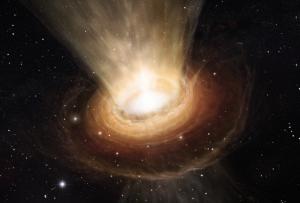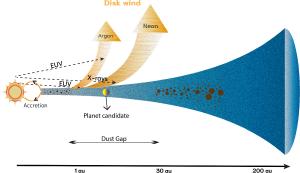Blog
Clearing the Room
6 March 2024
 ESO/M. Kornmesser
ESO/M. KornmesserNearly 5 billion years ago a region of gas gravitationally collapsed within a vast molecular cloud. At the center of the region, the Sun began to form, while around it formed a protoplanetary disk of gas and dust out of which Earth and the other planets of the solar system would form. We know this is how the solar system began because we have observed this process in systems throughout the galaxy. But there are details of the process we still don’t understand, such as why gas planets are relatively rare in our system.
Our solar system only has four gas planets. The rest are the rocky worlds of the inner solar system. Then there are countless asteroids and the icy worlds of Pluto and the outer solar system. Most of them don’t contain a lot of volatile gasses, which is strange because early protoplanetary disks typically have a hundred times more gas than dust. So how does a gassy disk evolve into a planetary system of mostly rock? The answer can be found in recent observations of a young system known as TCha.1
 Naman S. Bajaj, et al
Naman S. Bajaj, et alThe general idea is that during the later stage of planetary formation the central star increases in brightness. The light from the star then drives winds within the disk which clears any remaining gas from the system. While this model can explain the type of planetary systems we observe, the process hasn’t been observed directly. That is, until this recent study.
TCha is a system in the late stages of planetary formation. Earlier observations found it has a large dust gap within the disk with a radius of more than 30 AU, indicating that much of the early material has already cleared. So in this new study, the team used observations from the James Webb Space Telescope (JWST) to measure the spectral lines of ionized argon and neon. This study is the first observation of a particular argon line, Ar III.
The team made two main discoveries. The first is based on the ionizing energy levels, which indicates that argon is mostly ionized by extreme ultraviolet light, while neon is mostly ionized by X-rays. The second is that both gases are rapidly expanding away from the star, as seen by the Doppler shift of the spectral lines. Together these discoveries show that the gases are part of a stellar wind driven by high-energy photons.
Based on the observations, the team estimates that the TCha disk is losing about a Moon’s worth of mass every year, which is fast enough to clear the planetary disks in agreement with observations of planetary systems. While there are many details of planetary evolution we still don’t understand, this study supports the standard model.
Naman S. Bajaj, et al. “JWST MIRI MRS Observations of T Cha: Discovery of a Spatially Resolved Disk Wind.” The Astronomical Journal 167 (2024): 127. ↩︎